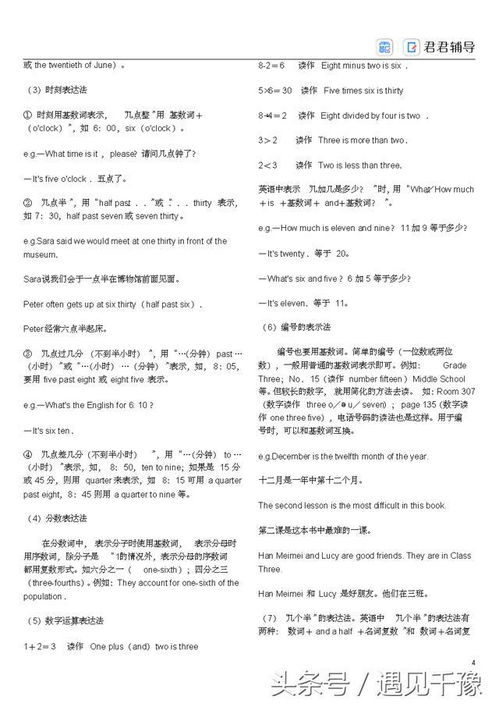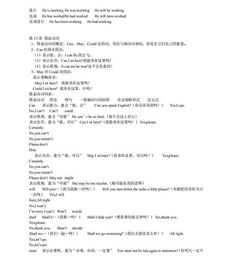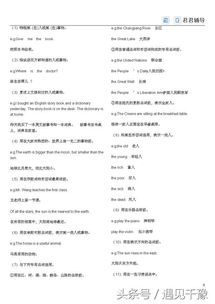初中最基础英语知识(初中英语有哪些)
1.初中英语基础知识 有哪些
由动词开头构成的短语、词组很多。
复习时应分类处理: 一、动词+介词 1.look at…看…, look like … 看上去像……, look after …照料… 2.listen to…听…… 3.welcome to…欢迎到…… 4.say hello to …向……问好 5.speak to…对……说话 此类短语相当于及物动词,其后必须带宾语,但宾语无论是名词还是代词,都要放在介词之后。 二、动词+副词 “动词+副词”所构成的短语义分为两类: A.动词(vt.)+副词 1.put on 穿上 2.take off脱下 3.write down记下 此类短语可以带宾语,宾语若是名词,放在副词前后皆可;宾语若是人称代词,只能放在副词的前面。
B.动词(vi)+副词。 1.come on赶快 2.get up起床 3.go home回家 4.come in进来 5.sit down坐下 6.stand up起立 此类短语属于不及物动词,不可以带宾语。
三、其它类动词词组 1.close the door 2.1ook the same 3.go to work/class 4.be ill 5.have a look/seat 6.have supper 7.1ook young 8.go shopping 9.watch TV/games 10. play games [介词短语聚焦] “介词+名词/代词”所构成的短语称为介词短语。现将Unitsl-16常用的介词短语按用法进行归类。
1.in+语言/颜色/衣帽等,表示使用某种语言或穿着……。 2.in + Row/ Team/ Class/ Grade等,表示“在……排/队/班级/年级”等。
3.in the morning/ afternoon/ evening/ 表示“在上午/下午/傍晚”等一段时间。 4.in the desk/ pencil-box/bedroom 等表示“在书桌/铅笔盒/卧室里”。
5.in the tree表示“在树上 (非树本身所有)”;on the tree表示“在树上(为树本身所有)”。 6.in the wall表示“在墙上(凹陷进去)”;on the wall表示“在墙上(指墙的表面)”。
7.at work(在工作)/at school(上学)/at home(在家)应注意此类短语中无the。 8.at + 时刻表示钟点。
9.like this/that表示方式,意为“像……这/那样”。 10.of短语表示所属关系。
11.behind/ beside/ near/ under+ 名词等,表示方位、处所。 12.from与to多表示方向,前者意为“从……”,后者意为“到……”。
另外,以下这些短语也必须掌握。如:on duty, after breakfast, at night, at the door, in the middle, in the sky, on one's bike等。
[重点句型大回放] 1.I think…意为“我认为……”,是对某人或某事的看法或态度的一种句型。其否定式常用I don't think…, 2.give sth. to sb./ give sb. sth. 意为“把……给……”,动词give之后可接双宾语,可用这两种句型;若指物的宾语是人称代词时,则只能用give it/ them to sb. 3.take sb./ sth. to…意为“把……(送)带到……”,后常接地点,也可接人。
4.One…, the other…/One is…and one is…意为“一个是……;另一个是……”,必须是两者中。 5.Let sb. do sth. 意为“让某人做某事”,人后应用不带to的动词不定式,其否定式为Don't let sb,do sth.,或Let sb. not do sth. 另外,Let's 与Let us的含义不完全相同,前者包括听者在内,后者不包括听者在内, 6.help sb. (to) do sth./help sb. with sth.意为“帮助某人做某事”,前者用不定式作宾补,后者用介词短语作宾补,二者可以互换. 7.What about…?/How about…?意为“……怎么样?”是用来询问或征求对方的观点、意见、看法等。
about为介词,其后须接名词、代词或V-ing等形式。 8.It's time to do…/ It's time for sth. 意为“该做……的时间了”,其中to后须接原形动词,for后可接名词或V-ing形式。
9.like to do sth./like doing sth.意为“喜欢做某事”, 前一种句型侧重具体的一次性的动作;后一种句型侧重习惯性的动作, 10.ask sb.(not) to do sth. 意为“让某人(不要)做某事”,其中ask sb.后应接动词不定式, 11.show sb. sth. / show sth. to do. 意为“把某物给某人看”,该句型的用法同前面第2点。 12.introduce sb. to sb. 意为“把某人介绍给另一人”;introduce to sb.则是“向某人作介绍”。
[重点短语快速复习] 1.kinds of 各种各样的 2. either…or…或者……或者……,不是……就是…… 3. neither…nor…既不……也不…… 4. Chinese tea without, anything in it 中国清茶 5. take a seat 就坐 6. home cooking 家常做法 7. be famous for 因……而著名 8. on ones way to在……途中 9. be sick/ill in hospital生病住院 10. at the end of在……的尽头,在……的末尾 11. wait for 等待 12. in time 及时 13. make one's way to…往……(艰难地)走去 14. just then 正在那时 15. first of all 首先,第一 16. go wrong 走错路 17. be/get lost 迷路 18. make a noise 吵闹,喧哗 19. get on 上车 20. get off 下车 21. stand in line 站队 22. waiting room 候诊室,候车室 23. at the head of……在……的前头 24. laugh at 嘲笑 25. throw about 乱丢,抛散 26. in fact 实际上 27. at midnight 在半夜 28. have a good time=enjoy oneself玩得愉快 29. quarrel with sb. 和某人吵架 30. take one's temperature 给某人体温 31. have/get a pain in…某处疼痛 32. have a headache 头痛 33. as soon as… 一……就…… 34. feel like doing sth. 想要干某事 35. stop…from doing sth. 阻止……干某事 36. fall asleep 入睡 37. again and again再三地,反复地 38. wake up 醒来,叫醒 39. instead of 代替 40. look over 检查 41. take 。

2.初中英语应该掌握的基本知识【全部】
1. welcome to s.p. 欢迎到……2. welcome here. 欢迎到这儿。
3. welcome there. 欢迎到那儿 4. welcome home. 欢迎到家里来。5. be going to do sth. 打算做……6. have fun doing sth. 愉快地做……7. call one's name 点名8. It doesn't matter. 没关系.9. on time 准时10. Thursday, September 10th 9月10日,星期四11. a card for sb. with one's best wishes 送给…的卡片,致以某人最良好的祝愿.12.Thank you for teaching us so well. 谢谢你教我们教得这么好.13.Thank you for your help. 谢谢你的帮助.14.Thank you for your hard work ! 谢谢你的辛勤工作.15.Best wishes for Teachers' Day ! 致以教师节最良好的祝愿 !16.We wish you a Happy Teachers' Day. 我们祝你教师节愉快 !17.want sb. to do sth. 要某人做某事18.give a talk to sb. = give sb. a talk 给某人做报告 19.give a talk to sb. about sth. 给某人做有关…的报告20.in class 在课堂上21.think about … 考虑……22.have an idea 有了一个主意23.talk about … 谈论有关……24.the difference between…and… …… 和……之间的区别/不同25.That's a good idea. 那是个好主意.26.full name 全名27.given name 起的名字28.first name 名字29.middle name 教名30.family name 姓31.last name 姓32.for example 例如33.to many people 对许多人来说34.the meaning of … ……的意思35.use sth. with sth. 把…和…一起使用36.be different from sth. 与…之间的不同37.be short for… 简称为……38.call….sth.forshort 把…简称为… ** 39.in English-speaking countries 在讲英语的国家40.one's close friend 某人的密友41.What is the difference between…and…? … 和…之间的不同点是什么? 42.such as… 象……43.of course 当然44.I'm not sure. 我不清楚.45.I'm afraid I've no idea. 恐怕我不知道.46.know a lot about sth. / sb. 非常了解某事/某人47.I'm going to the shop. 我打算去买东西.48.buy sth. for sb. = buy sb. sth. 给某人买某物49.make sb. a card 制作一张卡片50.give sb. one's best wishes 向某人致以最良好的祝愿51.wish sb. a Happy Teachers' Day 祝愿某人教师节愉快52.try to do sth. 尽力做某事53.try doing sth 试做某事54.the students at school 在校的学生55.sound like sth. 听起来象…56.sound + adj. 听起来…57.have to do sth. 不得不做…58.many times 许多次59.not…any more 不再…60.ask sb. to do sth. 叫某人做某事61.think of … 想/想起…62.a waste of time 浪费时间63.say sth. with a laugh 大笑着说… ***64.right now 就在现在65.email sb . 给某人发电子邮件66.write one's email 写电子邮件67.than before 比以前68.on a …trip 在…的旅行期间69.go on a …trip 去…的旅行70.take / make / have a trip 去…的旅行71.study about… 学习…72.of course当然73.go shopping / swimming / boating / skating / 去买东西/去游泳/去划船/去滑冰 walking / climbing / dancing / hiking / 去散步/去爬山/去跳舞/去远足 sight-seeing / house-hunting / hunting / 去观光/去找房子/去打猎 shooting / cycling 去射击/去骑车74. agree with sb. 同意某人75.a kind of … 一种的…76.some kinds of … 一些种类的…77.( many ) different kinds of … (许多)不同种类的…78.go to the mountain 去爬山79.have a field trip 去野外旅行80.go on a picnic 去野餐81.next holiday 下一个节日82.the day after tomorrow 后天83.on one's field trip 在野外旅行中84.hike to s.p. 徒步旅行到…85.on the top of the… 在…的顶上86.have a picnic 去野餐87.have a problem doing sth. 做…有一个难题88.have some problems ( in ) doing sth.做… 有一些困难89.go / hike the wrong way 走/旅行错了路90.start / begin to do sth. 开始做某事91.trip over sth. 被…绊倒92.get sb. to s.p. 把某人带到…93.Hurry up ! 赶快94.I'm tired. 我很累了.95.tie one's shoes 给某人的鞋子绑鞋带96.I'm going to die. 我快死了. ***97.pour water 倒水98.the first one to s.p. 达到…的第一人/最先达到…的人99.go to the party 去参加晚会100.go this way 这边走101.That's the wrong way. 那是条错路.102.It takes too long. 它太花时间了.***103.take sb. doing sth 带领某人做某事104.at that time 在那时105This is going to be fun. 这将很有趣106.See you then. 到那时见.107.fall into the lake 跌进湖里108.feel like… 觉得…109.take sth. with sb. 带上…110.get to s.p.达到…111.have a lot of fun hiking 有许多有趣的旅行 112.the coming field trip 即将到来的野外旅行113.go to s.p. for a field trip 到…去进行野外旅行114.be far from … 远离…***115.put sth. in order 有秩序地放好…116.have a good drink 大喝一顿117.take sth. out of … 把…拿出来118.eat a lot 大吃一顿119.The more, the merrier. 越多,越高兴. 120.Mid-autumn Festival 中秋节121.on Mid-autumn Day 在中秋节122.be free = have time 有空123.be free to do sth. 有空做……124.eat/have a big dinner/lunch/supper 吃一餐丰盛的饭/午饭/晚饭125.a small round cake with nuts and meat 有坚果和肉馅的小圆月饼126.something sweet 甜的东西。

3.初中英语中的基础知识是什么
其实英语没有级别之分的,最难的就是方开始学的英语。
如果要学好,笔者认为应从以下几方面去努力:
1、预习。预习既是学习方法问题,也是学习习惯的问题。预习的内容很多,如:课前要预习生词、课文和语法内容,在自己不懂的地方作上标记,带着问题有针对性去听课,课堂上尽力去解决自己不懂的问题,如仍不懂,课后应马上问老师。
2、听课。听课是学习过程中最重要的环节,听课效率高的学生往往能够在课堂上掌握教师讲授的大部分内容。听课要做到:紧跟各个教学环节,如复习、引入、呈现、练习和巩固等;要集中精力,听懂教师的讲解,并做好笔记;积极参与课堂活动,如回答问题、对话、角色扮演和复述等。
3、作业。要认真完成课后作业。英语作业分口头和笔头两种。对语言学习来说,朗读、记忆、背诵等课后作业十分重要。
4、复习与总结。课后要进一步理解课上所学的内容,如整理笔记、复习重点和难点;熟读或背诵重要句子;通过归纳、分析和比较,使知识条理化;根据个人情况有针对性地进行复习。
5、自备一本词典。对于重点词汇或易混词要勤查词典,学会用简单的英语去解释生词,其目的在于培养学生的自学能力,以便今后能正确使用英语词典等工具书,准确地理解词义。
自己试着分析结构比较复杂的长句子,如能理解长、难句,那么也就不难理解整篇文章了,这样也随之提高了阅读能力。
6、课外时间尽量多看些课外读物或英语报刊杂志,多读故事类、幽默笑话类材料,以便提高学习英语的兴趣。另外,可以辑一些英语谚语、警句等(如:Practice makes perfect. 熟能生巧;Where there is a will, there is a way.有志者,事竟成)。这样在扩大自己知识面的同时激励自己发奋学习。
7、多说英语,多背课文,培养语感;多写英语,锻炼自己的组词造句能力;课余时间要多与老师交流,解决遗留问题,坚持勤学好问。
4.初中英语基础知识
It is···(for sb)to do send sth to sb =send sb sth forget to do sth 忘记干某事 forget doing sth 忘记干过某事 finish doing sth 完成某事 the solar calendar阳历 the lundar calendar 阴历 adj(比较级)的用法: adj(比较级)+从属连词than引导的状语从句,此结构用于两者之间的比较,表示“比···更···” 例:The sun is bigger than the earth as+adj(原级)+as引导的时间状语从句的肯定结构,用于两者之间的同级比较,表示“···和···一样” 例:He is as funny as his father 11. 动词的时态 11.1 一般现在时的用法 1) 经常性或习惯性的动作,常与表示频腮度的时间状语连用。
时间状语: every…, sometimes, at…, on Sunday。例如: I leave home for school at 7 every morning. 每天早上我七点离开家。
2) 客观真理,客观存在,科学事实。例如: The earth moves around the sun. 地球绕太阳转动。
Shanghai lies in the east of China. 上海位于中国东部。 3) 表示格言或警句。
例如: Pride goes before a fall. 骄者必败。 注意:此用法如果出现在宾语从句中,即使主句是过去时,从句谓语也要用一般现在时。
例:Columbus proved that the earth is round. 哥伦布证实了地球是圆的。 4) 现在时刻的状态、能力、性格、个性。
例如: I don't want so much. 我不要那么多。 Ann writes good English but does not speak well. 安英语写得不错,讲的可不行。
比较:Now I put the sugar in the cup. 把糖放入杯子。 I am doing my homework now. 我正在做功课。
第一句用一般现在时,用于操作演示或指导说明的示范性动作,表示言行的瞬间动作。第二句中的now是进行时的标志,表示正在进行的动作的客观状况,所以后句用一般现在时。
返回动词的时态目录 11.2 一般过去时的用法 1)在确定的过去时间里所发生的动作或存在的状态。例如:时间状语有:yesterday, last week, an hour ago, the other day, in 1982等。
例如: Where did you go just now? 刚才你上哪儿去了? 2)表示在过去一段时间内,经常性或习惯性的动作。例如: When I was a child, I often played football in the street. 我是个孩子的时候,常在马路上踢足球。
Whenever the Browns went during their visit, they were given a warm welcome. 那时,布朗一家无论什么时候去,都受到热烈欢迎。 3)句型:It is time for sb. to do sth "到……时间了" "该……了"。
例如:It is time for you to go to bed. 你该睡觉了。 It is time that sb. did sth. "时间已迟了" "早该……了" ,例如It is time you went to bed. 你早该睡觉了。
would (had) rather sb. did sth. 表示'宁愿某人做某事'。例如:I'd rather you came tomorrow.还是明天来吧。
4) wish, wonder, think, hope 等用过去时,作试探性的询问、请求、建议等,而一般过去时表示的动作或状态都已成为过去,现已不复存在。例如:I thought you might have some. 我以为你想要一些。
比较:Christine was an invalid all her life.(含义:她已不在人间。) Christine has been an invalid all her life.(含义:她现在还活着) Mrs. Darby lived in Kentucky for seven years. (含义:达比太太已不再住在肯塔基州。)
Mrs. Darby has lived in Kentucky for seven years. (含义:现在还住在肯塔基州,有可能指刚离去) 注意: 用过去时表示现在,表示委婉语气。 1)动词want, hope, wonder, think, intend 等。
例如: Did you want anything else? 您还要些什么吗? I wondered if you could help me. 能不能帮我一下。 2)情态动词 could, would。
例如: Could you lend me your bike? 你的自行车,能借用一些吗? 返回动词的时态目录 11.3 used to / be used to used to + do:"过去常常"表示过去习惯性的动作或状态,但如今已不存在。例如: Mother used not to be so forgetful. 老妈过去没那么健忘。
Scarf used to take a walk. 斯卡夫过去常常散步。 be used to + doing: 对……已感到习惯,或"习惯于",to是介词,后需加名词或动名词。
例如: He is used to a vegetarian diet. Scarf is used to taking a walk. 斯卡夫现在已习惯于散步了。 典型例题 ---- Your phone number again? I ___ quite catch it. ---- It's 69568442. A. didn't B. couldn't C. don't D. can't 答案A. 本句虽没有明确的时间状语,但从语意上看出,在听的时候没有听懂这个动作发生在过去,因此应用过去时。
返回动词的时态目录 11.4 一般将来时 1) shall用于第一人称,常被will 所代替。will 在陈述句中用于各人称,在征求意见时常用于第二人称。
例如: Which paragraph shall I read first? 我先读哪一段呢? Will you be at home at seven this evening? 今晚七点回家好吗? 2) be going to +不定式,表示将来。 a. 主语的意图,即将做某事。
例如:What are you going to do tomorrow? 明天打算作什么呢? b. 计划,安排要发生的事。例如:The play is going to be produced next month。
这出戏下月开播。 c. 有迹象要发生的事。
例如:Look at the dark clouds, there is going to be a storm. 看那乌云,快要下雨了。 3) be +不定式表将来,按计划或正式安排将发生的事。
例如: We are to 。
5.初中英语基本知识
一、反义词: dangerous 危险的-safe安全的 difficult 难的 -easy容易的 exciting 激动人心的-boring枯燥的 expensive 昂贵的-cheap便宜的 popular 受欢迎的-unpopular不受欢迎的 relaxing 放松的-tiring累人的 badly 坏地-well好地 carefully 认真地-carelessly粗心地 late 晚-early早 loudly 大声地-quietly安静地 二.词汇 1. be good at sth 擅长某事 be good at doing sth 擅长做某事 例如:我哥哥擅长篮球。
My brother is good at basketball. 我哥哥擅长打蓝球。 My brother is good at playing basketball 在每周六上午九点半 at 9:30 am every Saturday 早到这儿 get here early 晚到那儿 arrive there late 坐在黑板前sit in front of the blackboard 在教室后面at the back of the classroom 三.句型 1. 位移动词用现在进行时表示将来时。
如: 她将去学校。 She is going to school. 她将离开学校 She is leaving for school. 2. It's +形容词 + to do sth 学习英语很难。
It's very difficult to learn English. 3. 对某人讲得又慢又大声 speak slowly and loudly to sb(宾格). slowly 和loudly为副词,副词修饰动词。 4.需要做某事need to do sth 我们需要每天打扫教室。
We need to clean the classroom every day. He needs to learn English quickly. How does he need to learn English? 5.想要做某事want to do sth 我们想要打蓝球。We want to play basketball. 6. No one 谓语动词用单数。
如:没人要踢足球。 No one wants to play football. 7. It's +物性形容词 +for sb to do sh 对他来说学习数学很简单。
It's very easy for him to learn math. work hard 努力学习/工作 (这里 hard 就是副词) speak English well 这里 well 就是副词 do some sightseeing 游览 go sightseeing 去观光 带某人参观……take sb. around … 将持续到……will continue until … 17. She likes running and she likes cycling, too. She likes running and she also likes cycling. also反在实义动词前,be动词和情态动词后。 18. 我不喜欢迟到。
I don't like to be late. 19. 我不喜欢跑步和骑自行车。I don't like running or cycling. 20. so 因此;所以 在英语句子中不能与because同时用 如:我饿了,所以想去买点吃的。
I'm hungry so I'm going to buy some food. 21. more +(形容词或副词)原级=比较级 more popular more exciting more dangerous more tired more quickly 22. much, a little, even +(形容词或副词)比较级 much bigger, much better, much more popular Pan Changjiang is funnier than Yao Ming. 句子中有than,要用比较级 比较级规则变化口诀: 比较级,要变化,一般词尾加er。(long-longer) 词尾若有哑音e, 直接加r就可以。
(nice-nicer) 重读闭音节, 单辅音字母要双写。(hot-hotter) 辅音字母若加y, 记得把y变为i。
(happy-happier)。
6.中考必备英语基础知识,全部
重点语法的部分 初中学过9种时态,课程标准要求掌握6种:一般现在时;一般过去时;现在进行时;过去进行时;一般将来时;现在完成时。
另外三种了解即可,中考不作考查:过去将来时;过去完成时;现在完成进行时。一般现在时: 句子结构: 肯定句 主语+be (am, is, are ) + 其他 否定句 主语+be not +其他 疑问句 Be+主语+其他 或: 肯定句 主语+动词原型+其他 ( 第三人称单数作主语动词要加"s" ) 否定句 主语+don't+动词原型+其他(第三人称单数作主语don't改为doesn't) 疑问句 DO+主语+动词原型+其他(第三人称单数作主语do改为doess) 关键词: sometimes, often, usually, always, every day, on Sunday afternoon, at 10 o'clockin the morning, five days a week, three times a month等. 注:在时间壮语从句,条件壮语从句中,常用一般现在时表示将来时,这时一般从 句用一般现在时,主句用将来时 现在进行时: 句子结构:肯定句 主语+be +动词的现在分词+其他 否定句 主语+be not+动词的现在分词+其他 疑问句 Be +主语+动词的现在分词+其他 关键词:now, right now, at the moment, It's+几点钟等的句子.或look, listen, keep quiet等提示语. 一般将来时: 句子结构: 肯定句 主语+will+动词原型+其他 否定句 主语+will not +动词原型+其他 疑问句 Will +主语+动词原型+其他 (will 可改为be going to ,当主语是第一人称时will可用shall) 关键词:tomorrow, tomorrow morning, at seven o'clock tomorrow evening, next year, at ten o'clock next Sunday, this year, at the end of this term, from now on, in the year 2008, soon, in a few days' time, in the future 等. 一般过去时: 句子结构:肯定句 主语+be(was,were)+其他 否定句 主语+be not+其他 疑问句 Be+主语+其他 或: 肯定句 主语+动词的过去式+其他 否定句 主语+did not+动词原型+其他 疑问句 Did+主语+动词原型+其他 关键词:yesterday,yesterday morning等 ,last week, last year, at the end of last term, 一段时间+ago如:ten years ago, five hours ago, on January 1st,2004, in the 1980s等. Just now,in the old days, long ago, a moment ago等. 过去进行时: 句子结构: 肯定句 主语+was/were+动词的现在分词+其他 否定句 主语+was/were not +动词的现在分词+其他 疑问句 Was/Were + 主语+ 动词的现在分词+其他 关键词:具体时间+过去的时间壮语 如:at ten o'clock yesterday morning, at this time last Sunday等. 现在完成时: 句子结构:肯定句 主语+have/has+动词的过去分词+其他(第三人称单数用has) 否定句 主语+have/has not+动词的过去分词+其他 疑问句 Have/Has + 主语 + 动词的过去分词+其他 关键词:already, yet, just, ever, never ,so far, for +一段时间,since+过去的 时间或过去时从句.或this year alone"今年以来",these five years alone"这五年 以来",in the last ten years "在过去的十年中"等. 过去将来时: 句子结构: 肯定句 主语+ would+ 动词原型+其他 否定句 主语+ would not + 动词原型+ 其他 疑问句 Would+主语+动词原型+其他 (would可改为was/were going to ,主语第一人称时would可用should) 过去将来时主要用在宾语从句中. 过去完成时: 句子结构: 肯定句 主语+had + 动词的过去分词+其他 否定句 主语+had not +动词的过去分词+其他 疑问句 Had+主语+动词的过去分词+其他 关键词:by+过去某一时间点 如:by last year, by the end of+过去某一时间点 如: by the end of last year, before+过去某一时间点,by the time +从句,或宾语从句中.其实初中英语全部知识都包含在你课本里啦,高中英语考能力比较多。
多看看你的笔记,改错本,复习好课本就OK。如果你以前没好好学英语,最后一年恶补的话。
如果底子好就没问题。我中考英语是满分,也祝你英语成绩能提高,取得好成绩。
7.初中的英语语法知识都有什么
不知道
没看过人教版教材
你是要升初中了还是?
初中也就学一些基础语法
最重点的是几种比较简单的分句(从句)
也就是宾语从句、定语从句
以及条件、地点、时间、原因、结果、目的(还不一定学,因为目的和结果的最简单的从属连词都是so,有点混淆)、让步状语从句
方式、比较状语从句应该不学
还有时态
一般现在时不用说
现在进行、一般过去、一般将来、现在完成、过去完成、过去进行、过去将来肯定也要学
(过去、现在、将来)完成进行时和将来进行时很难,肯定不学
就是不知道将来完成时学不学
另外还有情态动词、宾语补语、简单句五种基本句型、并列句连带并列连词一并学了,还有关联连词
另外就是和宾语从句基本类似的直接引语和间接引语
还有主动语态和被动语态、
另外代词的反身代词、动词的现在分词、过去分词、过去式、不定式什么的都是很简单的基础
总体上几乎没什么语法
初中主要是积累词汇量
要是想打好语法基础,找本语法书把虚拟语气学会
那其他从句就完全不成问题了
除了主语从句有些困难
8.求初中英语所有知识点总结~
初中英语总复习(100多页的内容,涵盖从初一到初三所有知识点绝对经典,是每个九年级英语教师必备资料) 名词的数 1、可数名词与不可数名词 A、不可数名词,初中阶段常见的不可数名词有:water ; meat ; rice ; bread ; milk ; tea ; orange(桔汁) ; fruit ; air ; snow ; chalk; work ; paper(纸) ; time(时间); music ; weather ; grass ; news ; food ; fish(鱼肉); coke ; porridge ; cake(可数或不可数). 不可数名词应注意以下几点: 1)前无数、冠,后无复数;作主语为三单. 2)表量用约数some /any ; much ; a lot of 或用of短语 eg. There is ____ bread on the table. [C] A. a B. one C. a piece of D. many There is some_______ on the plate. [B] A. apple B. fish C. milks D. deer 这是些例题 你可以到这个网站去下载 全部 如果全部给你复制起来字数就超过限制了(限制为2000 这点非常不好 不知道TX为什么搞什么限制)。

相关推荐
声明:本网站尊重并保护知识产权,根据《信息网络传播权保护条例》,如果我们转载的作品侵犯了您的权利,请在一个月内通知我们,我们会及时删除。
蜀ICP备2020033479号-4 Copyright © 2016 学习鸟. 页面生成时间:2.838秒









